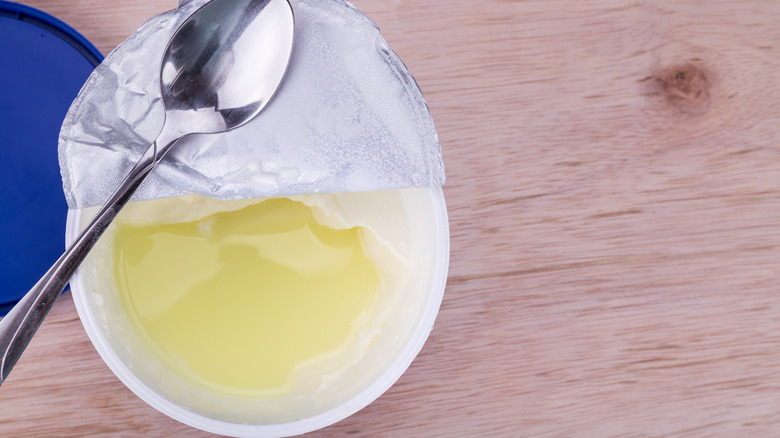How To Tell When Your Yogurt Has Gone Bad
What makes a healthy, refreshing smoothie or a sweet, tangy parfait a hit? It's the fresh and creamy yogurt that takes the credit. Yogurt is packed with nutrients, probiotics, and protein and is used in so many delicious recipes that you always keep a pack of it in your refrigerator. But, like most dairy foods, its shelf life is limited – one or two weeks if refrigerated. It can be tempting to toss it out, the moment it crosses the date on the packaging, but wait! Maybe your yogurt is still good to use.
According to the U.S. Department of Agriculture, the "Best If Used By" or "Best if Used Before" date isn't an expiration date. Instead, it's only an estimation of the date your food will lower in quality. It's the manufacturer's belief that up until that date, your food product should have the best flavor and texture; it doesn't necessarily mark when your food has gone bad or spoiled. Ultimately, a use-by date only indicates the last date to use the product when it is still in its best form. So, even if your yogurt has crossed these dates, there is still a good chance it is safe for consumption. So how do you decide that? With some simple tests and a good sense of judgment.
Is your yogurt good or bad?
To start, check your packaging. Although the Best By and Use By date are not a reliable marker of freshness, if your yogurt container is bloated, damaged, or shows signs of leakage, it may have been compromised, and it's safer to discard it.
When you open your container, first trust your sense of smell. The nose knows so give your yogurt a sniff, if the yogurt has a sour, off-putting, or rancid odor, it may have gone bad. Do keep in mind that even fresh yogurt has a mild tangy aroma, but a noticeable deviation from this scent suggests spoilage.
If everything smells okay, look for signs of discoloration and mold. Yogurt is typically white or slightly off-white. If you see any unusual colors, such as pink, green, or blue, it means that the yogurt has gone bad. These spots and discoloration could be mold, which you should always be on the lookout for. If you see mold, unusual growths, or a fuzzy appearance on the surface of the yogurt, discard it immediately. Attempting to remove the mold from the surface will not save the yogurt, as mold spores penetrate deep into food, according to the University of Minnesota.
You'll also want to inspect the texture of your yogurt. Fresh yogurt is smooth and creamy. If it has become unusually thick, lumpy, or separated into curds and whey, these are telltale signs of decomposition, and it is best to throw it away. Check for a thick liquid layer: It is normal for yogurt to have a thin layer of liquid on the surface that can easily be reincorporated into the yogurt. However, if you notice a high volume of liquid or a thick layer of liquid on the top, give it a stir. If you see clumps or lumps, the yogurt has probably gone bad.
Finally, there's always a taste test. Although it is not recommended to consume yogurt displaying any signs of spoilage, if you do accidentally consume it or take a taste test, pay attention to any unfamiliar flavors. If it tastes sour, bitter, or unpleasant, it's best to discard it.
Preventing the yogurt from going sour
Yogurt is a delicate food item and should be stored properly. According to U.S. Dairy, yogurt should be stored at a temperature of 40 degrees Fahrenheit or below. Also, don't leave yogurt out at room temperature for a long time as it can speed up its spoiling so use and put it back in the refrigerator as soon as possible. Here's another thing to keep in mind: never store yogurt in the door of your fridge. It's better to store it in the back of the refrigerator, which has a cooler temperature and will help increase the shelf life of your yogurt.
If you're worried about wasting the yogurt bought from the market, consider making your own homemade yogurt so you can have exactly the amount you need when you need it. If you're making yogurt on demand, you'll be a lot less likely to have containers of it sitting in your fridge for a long time. Instead of worrying if your yogurt has gone bad, you can spend your time thinking about how to turn it into delicious recipes like creamy fruit salad or yogurt-dipped strawberries.


